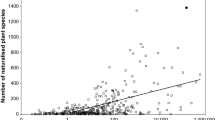Abstract
Fifteen years of field tests were conducted in California on 1,200 plots infested with the annual puncturevine (Tribulus terrestris L.) in order to examine the effect of 2 introduced weevils,Microlarinus lareynii (Jacquelin du Val) andM. lypriformis Wollaston (Col.: Curculionidae), on puncturevine. Since 5 of the 6 series of plots marked a substantial reduction in viable seed production and puncturevine coverage, it is suggested that the 2 introduced weevils curtailed the pucturevine population's capacity to compensate in the natural situation and significantly contributed to the decline in puncturevine density.
Résumé
Des essais de terrain ont été effectués, pendant 15 ans, en Californie, dans 1.200 parcelles infestées par la mauvaise herbe annuelle, la tribule (Tribulus terrestris L.), afin d'éprouver l'effet de 2 charançons introduits,Microlarinus lareynii (Jacquelin du Val) etM. lypriformis (Wollaston) (Col.: Curculionidae). Du fait que 5 des 6 séries de parcelles ont présenté une diminution substantielle de la production en graines viables et de la surface couverte par la tribule, on suggère que les 2 charançons introduits ont restreint la capacité de récupération de la population de tribule dans les conditions naturelles et ont contribué de façon significative à la réduction de la densité de cette mauvaise herbe.
Similar content being viewed by others
References
Andres, L.A. &Angalet, G.W. — 1963. Notes on the ecology and host specificity ofMicrolarinus lareynii andM. lypriformis [Coleoptera: Curculionidae] and the biological control of puncturevine,Tribulus terrestris. —J. Econ. Entomol., 56, 33–40.
Goeden, R.D. &Ricker, D.W. — 1967.Geocoris pallens found to be predaceous onMicrolarinus spp. introduced, to California for the biological control of puncture vine,Tribulus terrestris. —J. Econ. Entomol., 60, 725–729.
Goeden, R.D. &Ricker, D.W. — 1970. Parasitization of introduced puncturevine weevils by indigenouschalcidoidea in southern California. —J. Econ. Entomol., 63, 827–831.
Huffaker, C.B., Ricker, D.W. &Kennett, C.E. — 1961. Biological control of puncturevine with important weevils. —Calif. Agric., 15 (12), 11–12.
Hurst, E. — 1942. The Poisonous Plants of New South Wales. —Poisonous Plants Committee of New South Wales. Sidney, Snelling, 498 pp.
Johnson, E. — 1932. The puncturevine in California. —Univ. Calif. Agric. Exp. Stn. Bull., 528, 1–42.
Kirkland, R.L. &Goeden, R.D. — 1977. Descriptions of the immature stages of imported puncturevine weevils,Microlarinus lareynii andM. lypriformis. —Ann. Entomol. Soc. Am., 70, 583–587.
Kirkland, R.L. &Goeden, R.D. — 1978a. Biology ofMicrolarinus lareynii [Col. Curculionidae] on puncturevine in southern California. —Ann. Entomol. Soc. Am., 11, 55.
Kirkland, R.L. &Goeden, R.D. — 1978b. Biology ofMicrolarinus lypriformis [Col. Curculionidae] on puncturevine in Southern California. —Ann. Entomol. Soc. Am., 71, 65–69.
Kirkland, R.L. &Goeden, R.D. — 1978c. An insecticidal-check study of the biological control of puncturevine (Tribulus terrestris) by imported weevils,Microlarinus lareynii andM. lypriformis [Col.: Curculionidae]. —Environ. Entomol., 7, 349–354.
Maddox, D.M. — 1976. History of weevils on puncturevine in and near the United States. —Weed Sci., 24, 414–419.
Maddox, D.M. — 1981. Seed and stem weevils of puncturevine: a comparative study of impact, interaction, and insect strategy. —Proc. 5th. Int. Symp. Biol. Control Weeds, Brisbane, Australia, 447–467.
Maddox, D.M. &Andres, L.A. — 1979. Status of puncturevine weevils and their host plant in California. —Calif. Agric., 33 (6), 7–8.
Squires, V.R. — 1979. The biology of Australian weeds. 1.Tribulus terrestris L.. —J. Aust. Inst. Agric. Sci., Ser. 1, 75–82.
Van Tonder, E.M., Basson, P.A. &Van Rensburg, I.B.J. — 1972. Geeldikkop: experimental induction by feeding the plantTribulus terrestris [Zygophyllaceae]. —J.S. Afr. Vet. Assoc., 43, 363–375.
Author information
Authors and Affiliations
Rights and permissions
About this article
Cite this article
Huffaker, C.B., Hamai, J. & Nowierski, R.M. Biological control of puncturevine,Tribulus terrestris in california after twenty years of activity of introduced weevils. Entomophaga 28, 387–400 (1983). https://doi.org/10.1007/BF02372193
Issue Date:
DOI: https://doi.org/10.1007/BF02372193




